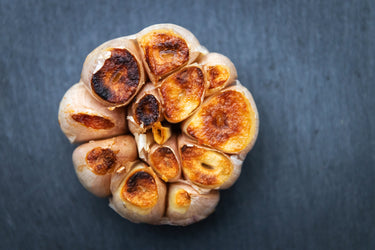8 Clever Garlic Tips

Few foods inspire as much intense feeling as garlic. This pungent allium has been cultivated for over 5,000 years, and for good reason: Garlic can add complexity to savory dishes, both adding flavors of its own and enhancing other flavors. However, when not cooked properly, garlic can be bitter or harsh, or in too large quantities, can overwhelm a dish. Fear not—these 8 clever tips will help you tame garlic, allowing it to be as strong or mellow as you like.
You might be surprised to learn that garlic doesn’t need a long time to coax out its flavors. In fact, around 30 seconds sizzling in fat is all you need. So, if a recipe says to add the garlic with the onions, think again! That’s likely to lead to burnt, bitter flavors infusing the food.
When chopped, sliced, grated, or smashed, raw garlic releases an intense aroma that can be too much for some eaters. Cooking changes these chemical compounds, making them sweeter, complex, and pleasantly rich.
The more you rupture the cells in garlic that release its flavor compounds, the more intense it will be. That’s why minced garlic is stronger than sliced garlic, which is in turn stronger than a crushed clove. For strong garlic flavor, mince with your knife, purée in a mortar and pestle, use a garlic press, or pulverize the cloves in a miniature food processor.
Garlic stays freshest when the entire bulb is left intact, and if stored in a cool, dark place, is likely to stay fresh for a couple months. Once you break apart the cloves, they’ll start to age more quickly, somewhere in the vicinity of a few days to a week. Garlic stored in the refrigerator is likely to sprout. Though the green sprout is edible, it can be bitter and unpleasant for some.
Sure, you can drop garlic cloves in a bowl of warm water and wait 15 minutes, or shake them in a container until the skin comes off, or stick a knife tip into the bulb to “slip” a clove out (a great way to ensure a kitchen accident). The best way to peel garlic is simple:
- Separate a clove from the bulb.
- Use the tip of your knife to slice off the root of the clove (the small, flat part at the end).
- Then, place the wide, flat side of the knife on the clove and whack the side of the knife with the heel of your hand just hard enough to loosen the skin.
- Use your fingers to peel off the skin.
If you’re crazy for garlic and/or happen to have a surplus of heads on hand, making garlic confit transforms the cloves into deeply complex, nutty nuggets perfect for adding to pasta, soups, sauces, and even hummus. Want to try it? We like Food&Wine’s recipe for garlic confit. Bonus: save the oil after eating the cloves to make garlic-infused salad dressing.
Even easier than confiting garlic is roasting garlic, which metamorphoses a head of garlic as if by magic into a caramelized spread, ideal for stirring into mayonnaise, mashing into baked potato, or spreading on buttered toast. It’s easy to roast multiple heads of garlic at once. You can freeze the roasted cloves for a few months and defrost them a few at a time. We love this recipe from Delish for roasted garlic.
If you’ve noticed your garlic turning green, fear not. As J. Kenji López-Alt explains at Serious Eats, Some older garlic cloves will turn green, which happens when the chemical precursors present in the garlic are released through cutting and react with other chemical precursors. These are the same compounds that have to do with intensity of flavor, so if the garlic turns green, it’s likely to be extra strong. If you find this unpleasant, keep your garlic cloves refrigerated and avoid adding acid in the cooking process before you’ve cooked the garlic.





